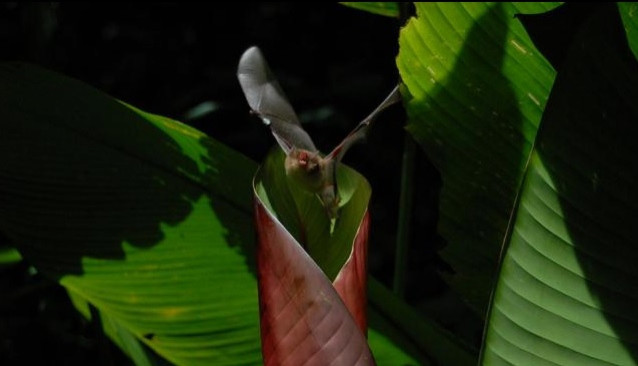Costa Rica Bats Use Rolled-Up Leaves As ‘Trumpets’ To Amplify Calls [PHOTO]

Scientists studying Spix’s disk-winged bats, a leaf-dwelling bat native to South America, found that the creature uses furled leaves to amplify the calls of their friends flying overhead – like Mother Nature’s version of a hearing aid.
The Spix’s disk-winged bat, a tiny species of bat whose average weight is just 4 grams, makes its home in the curled-up leaves outside caves. Because the bats are so small, several of them can fit in one leaf. The bats are also extremely cliquish, forming groups of five or six individuals who stay together when they're not out hunting for insects.
Roosting in the leaves is also a way for the bats to escape inclement weather and predators.
To locate other bats in their roosts, Spix’s disk-winged bats call for one another, but previous studies have shown that the bats are not very good at discerning whether a call is coming from a bat they know well or a total stranger. That got two researchers wondering if the bats' way of sheltering in curled leaves also aided in their recognition of each other’s calls.
“We started to wonder if the leaf was somehow affecting call fidelity,” Gloriana Chaverri, a researcher from the University of Costa Rica, told National Geographic. “Then, given the shape of the leaf, we began to wonder if the leaves could increase sound intensity while affecting fidelity, much like acoustic horns do.”
Chaverri and fellow biologist Erin Gillam from North Dakota State University designed an experiment to test how the leaves’ structure influenced incoming and outgoing bat calls. They inserted a speaker at both ends of the furled leaves and played the bats’ recorded social calls. They also placed a microphone at the opposite end of the speaker to record how the leaf structure amplified the sound.
National Geographic reported that the researchers found the funneling effect of the leaf effective in amplifying incoming calls but not outgoing ones.
In other words, the leaves didn’t make good megaphones, but they did make excellent hearing aids. Live Science noted that a call heard from within the leaf was up to 10 decibels louder than a call from outside the leaf. That increases the distance from which a flying bat can be heard from 65 feet to 98 feet.
Oddly enough, researchers noted that the leaves also significantly distorted the bats' “inquiry” and “response” calls – the signature calls the bats use to find their roost-mates. But they did find that the flying bats had an easier time recognizing the response calls of the roosting bats than the other way around.
The next step is to determine if the bats are in the habit of selecting leaves based on their perceived ability to amplify sounds.
The researchers' report appears in today’s edition of the journal Proceedings of the Royal Society B.
© Copyright IBTimes 2025. All rights reserved.






















